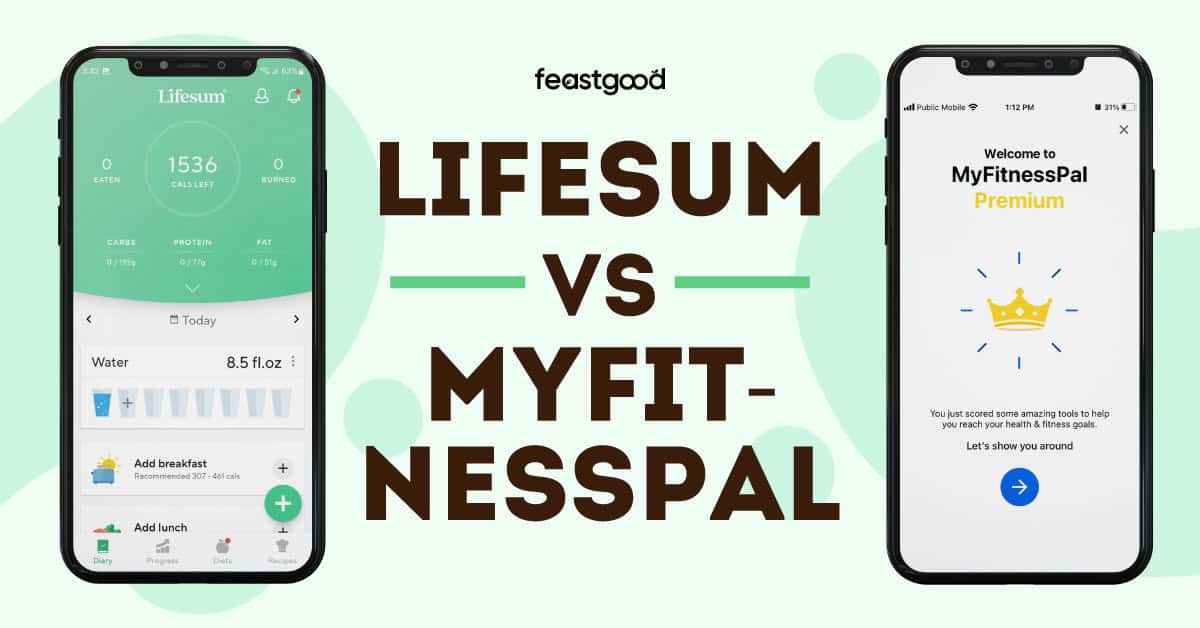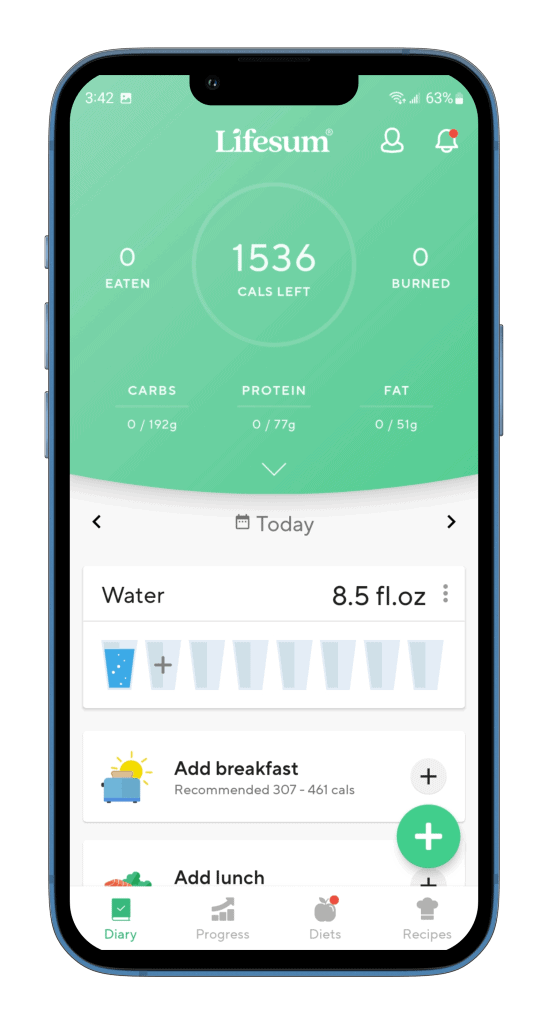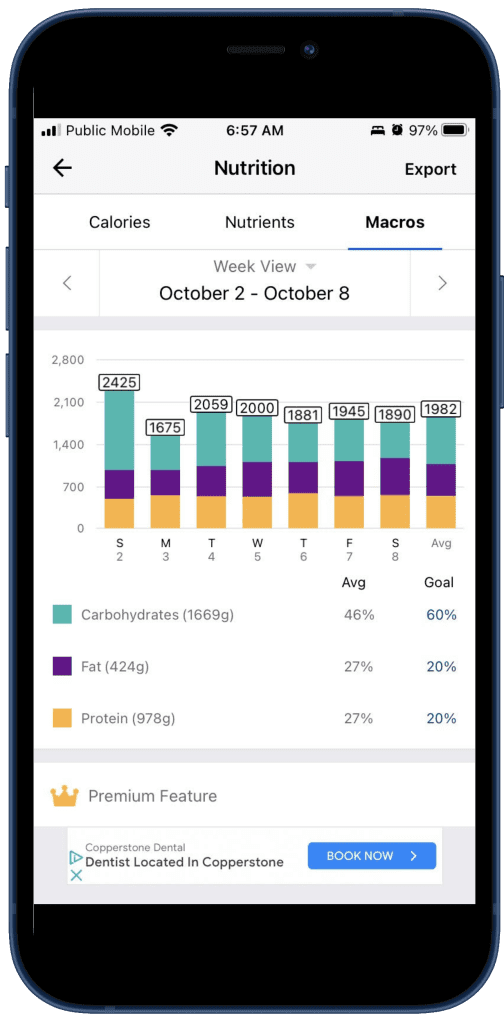Some links in this article are affiliate links, which means we earn from qualifying purchases. Learn more.
After 3+ years of using MyFitnessPal and spending the better part of 2023 using Lifesum, I’ve learned each app’s strengths and weaknesses. To help you decide between the two, I’ve highlighted their pros and cons and compared them across ten key categories, including food database accuracy, level of personalization, tracking capabilities, and more.
Key Takeaways
- The main difference between the two apps is that MyFitnessPal focuses strictly on calorie and macro tracking. In contrast, Lifesum offers habit tracking, meal plans, food quality insight, and calorie and macro tracking capabilities.
- Lifesum is best for those knowledgeable enough to set their own calorie and macro targets or those working with a nutrition coach. It’s also better for recipe inspiration and habit-tracking capabilities.
- MyFitnessPal is great for those who want a more extensive food database and can identify when nutrition information is inaccurate (since the database contains “unverified foods”). It’s also better for those who travel internationally or eat out at restaurants more often.
Honest Review Guarantee from FeastGood: Our testing team purchases each product 100% independently and uses the product for several weeks up to several months before writing a review. Learn more about our review process here.

Overall Rating: 3.7/5
Medical Disclaimer: The content of this article is provided for educational insights only. It should not be used as medical guidance. Individuals with a past of disordered eating should refrain from weight loss programs or calorie tracking. For medical advice, consult a certified healthcare professional. If you’re struggling with eating disorders, contact NEDA for assistance.

What Is Lifesum?
Lifesum is a nutrition app that allows seamless tracking of calories and macronutrients. The app’s primary purpose is to help people lose weight, but users can also select weight maintenance or weight gain as their primary goal.
Lifesum gets to know you by asking basic questions about body weight, height, and goal weight to determine your caloric expenditure and ideal intake; however, unlike other nutrition apps, it doesn’t factor in your activity level.
For instance, if Lifesum calculates your expenditure to be 2,000 calories and you select weight loss as your primary goal, you can select how quickly you want to shed pounds. The app will lower your calorie target accordingly.
Although the app provides calorie recommendations, it allows users to customize their nutritional targets if they deem those offered by the app inaccurate. You will need this feature because Lifesum’s recommendations are quite inaccurate (they exclude activity from their calculations).
Lifesum is mainly used for its extensive food and recipe database and meal plans, giving users plenty of flexibility and structure with their diet (depending on their preference). The Lifesum app even tailors to those following specific diets––keto, vegan, etc.
Check out my full review of Lifesum.
Pros
- Tracks calories and macronutrients (proteins, carbs, and fats)
- Manually adjust your nutritional targets, if necessary
- Extensive food and recipe database
- Meal plan options for specific diets
- Health Test to highlight areas in need of improvement
Cons
- The recommended nutritional targets tend to be inaccurate (lower than necessary)
- Some of the meal plans are too restrictive
- Most of the valuable features are not available on the free version
Lifesum Health App
This link gets you 50% off the annual plan. No code is required
What Is MyFitnessPal?
MyFitnessPal is the oldest and perhaps the most popular calorie and macronutrient-tracking app. It has been around for nearly two decades, beginning as a desktop program and launching as an iPhone app in late 2009.
MyFitnessPal works similarly to other nutritional apps by asking basic questions (including activity) to gather data to estimate dietary needs. From there, it gives you calorie and macronutrient recommendations based on your primary goal: weight loss, maintenance, or weight gain).
Users can take the app’s nutritional targets and run with them or adjust them if they seem inaccurate. With the free version, you can change your targets to the nearest 5%, whereas with the premium version, you can customize the exact gram for each nutrient.
MyFitnessPal may have the largest food database of all the nutrition apps on the market, meaning you can find food entries for nearly everything, including restaurant menu items.
That said, the food database is as extensive as it is because users can add entries to the database as a form of crowdsourcing. These entries are filled with user error and are not verified to be accurate before becoming publicly available. For this reason, a large percentage of MFP’s database is inaccurate.
Once upon a time, MyFitnessPal was the go-to app for those tracking their calories and macros. Its reviews are becoming more negative as once free features (e.g., barcode scanner) now require a premium membership.
Check out my full review of MyFitnessPal.
Pros
- It allows for calorie and macronutrient tracking
- It has one of the largest food databases, allowing users to track restaurant meals
- The interface is user-friendly and straightforward
Cons
- Its food database is filled with inaccurate nutritional information
- The free version is frustrating to use because of the ads
- The barcode scanner is only available to paying members
Lifesum vs. MyFitnessPal: Head To Head Comparison
To highlight Lifesum’s and MyFitnessPal’s capabilities, I’ve compared them in 10 key categories to see which app comes out on top.
1. Food Database
Lifesum
Lifesum has a large food database, and many foods have been verified to show accurate nutritional data, which can be identified with a blue checkmark.
However, like MyFitnessPal, users can also add their foods and meals to the database, which means there are bound to be some inaccurate entries.
To ensure accuracy when logging your food, stick to entries with a blue check mark and avoid other entries as much as possible.
MyFitnessPal
One of the things that made MyFitnessPal explode in popularity back in the day was the ability for users to add to the food database. This feature meant millions of foods, ingredients, and meals with nutritional information were available.
However, these inaccurate entries make tracking calories and macronutrients more frustrating and defeat the purpose of tracking your intake.
That said, the database is still valuable for those experienced enough to spot inaccuracies and who often eat restaurant meals or travel internationally.
The Winner: Lifesum
Although MyFitnessPal has a much more extensive food database, Lifesum is the winner because of its abundant database of verified foods.2. Tracking Capabilities
Lifesum
Lifesum allows users to track their calories, macronutrients, two minerals (sodium and potassium), exercise activity, body weight, circumference measurements, and certain habits.
MyFitnessPal
MyFitnessPal allows users to track calories, macronutrients, vitamins, and minerals (including vitamins A and C, calcium, iron, sodium, and potassium), water intake, exercise activity, steps taken, body measurements (including body weight and body fat percentage, neck, waist, and hip circumferences), and progress pictures.
The free version doesn’t have the barcode scanner, so non-premium users must manually input foods more often.
The Winner: MyFitnessPal
Both apps have similar tracking capabilities (especially the free versions), but MyFitnessPal tracks more micronutrients (vitamins & minerals) than Lifesum and allows users to upload progress pictures.3. Calorie Recommendations
Lifesum
Lifesum’s calorie recommendations are too low because they failed to factor the user’s activity level into their calorie calculations. These inaccurate calorie recommendations also negatively affect the protein recommendations.
Calorie and protein targets that are too low will cause muscle loss, extreme hunger, and low energy, so users of this app must adjust their targets. This calculator can help you set more appropriate targets.
MyFitnessPal
Calorie recommendations tend to be low, but not as low as Lifesum, because MFP factors in the user’s activity level.
I still recommend adjusting your calorie and macronutrient targets yourself or with the help of a coach rather than relying on MFP’s recommendations.
The only downside of setting your own macronutrient targets with MFP is that the free version allows you to adjust them only to the nearest 5%. You must pay for the premium version to set specific protein, carb, and fat goals.
The Winner: MyFitnessPal
Although neither app provides accurate calorie and macronutrient recommendations, MyFitnessPal tends to be more precise.With MFP, users can adjust their calories and macronutrients on the free version (to the nearest 5%), whereas those using Lifesum can only adjust with a premium plan.
4. Level of Customization
Lifesum
Lifesum allows users to customize their calories and macronutrients with a premium plan. Users can also customize their experience by adjusting their preferred rate of loss, following a meal plan (keto, paleo, clean eating, etc), and selecting habits goals.
MyFitnessPal
The free version of MyFitnessPal allows users to customize their calorie and macro targets to some extent, but the app’s premium version is required for complete customization of nutritional targets.
The Winner: Lifesum
Although MyFitnessPal is better as a free option because users can adjust their calories and macronutrients without paying for a premium plan, I’m declaring Lifesum the winner because there are more opportunities to personalize your experience beyond calories and macros.5. Educational Opportunities
Lifesum
Although Lifesum isn’t designed to be an educational app, it provides ratings, nutritional information, and pros and cons for each verified food in its database, helping users learn about the quality and quantity of foods they eat.
MyFitnessPal
MyFitnessPal is similar to Lifesum in that it isn’t designed to provide education and is simply a tool to help users keep track of their intake. MyFitnessPal offers nutritional information for each food, but it does not give the user context about the quality of the food.
The Winner: Lifesum
Both apps provide users with basic nutritional information, helping them better understand the composition of each food and how it affects their diet and energy intake.However, Lifesum takes this a step further by giving the user context about the quality of the food using a rating and a list of benefits and drawbacks.
6. Coaching
Lifesum
There are no options for Lifesum users to work with a coach inside the app. However, the app does provide daily, weekly, and monthly reports that you can send to your coach so they can advise you on how to manipulate your targets to stay on track with your goal.
MyFitnessPal
MyFitnessPal doesn’t offer ‘in-house’ coaching services, but users can turn on diary sharing and provide their coaches with some access to their food journal. That said, the visibility isn’t great, and the coach doesn’t have options to alter targets inside the app.
The Winner: Tie
I’m declaring it a tie because the reports from Lifesum are just as helpful as the direct access that MFP provides to coaches.7. Recipe Database
Lifesum
Lifesum has a ton of healthy recipes for users, including recipes for various diets and specific food preferences. The recipes are complete with nutritional information.
MyFitnessPal
One of the newer features on MyFitnessPal is Recipe Discovery, which allows users to find recipes based on category (e.g., keto diet) or hashtag (e.g., immune support).
Premium users can import one or more servings of a recipe into their diary, which is convenient and reduces the need for manual input. However, it’s worth noting that this method is only effective if you follow the original recipe strictly.
The Winner: Tie
The recipe database category is among the most difficult to pick a winner as both apps offer unique benefits. On the one hand, Lifesum has thousands of great recipes, many of which are easy to make.On the other hand, MyFitnessPal has a more sophisticated search engine that allows users to filter by category or hashtag.
MyFitnessPal is perhaps slightly better because it offers plenty of fantastic recipes in its free version. That said, the Lifesum recipes are worth paying for a premium subscription.
8. Exercise Calories
Lifesum
Lifesum allows users to track the number of calories burned during exercise. However, the app defaults to adding these burned calories to your daily target. You can turn off this feature, but only with the premium version.
MyFitnessPal
MFP can also track the calories burned through exercise and, by default, adds them back into your intake. However, you can turn off this feature if you want to lose weight, as it makes achieving a calorie deficit more difficult.
The Winner: MyFitnessPal
Both apps have similar capabilities in this category, with the ability to turn off this feature, but you can do it for free with MFP, whereas you have to pay for premium with Lifesum.9. Price
Lifesum
Lifesum has a free version, but you must pay for the premium version to access all its features.
There are three payment options for the premium version:
- Monthly – $9.99, billed every month
- Quarterly – $24.99, billed every three months ($8.33/month)
- Annual plan – $49.99, billed annually ($4.17/month)
MyFitnessPal
MyFitnessPal also has a free version, but you must pay for premium to access all its features (including the barcode scanner).
Premium costs $79.99 for a year ($6.66/month) or $19.99 monthly. A one-month free trial is also available, giving you plenty of time to test the app before committing.
The Winner: Lifesum
Lifesum is the better option because it’s cheaper overall and has similar (if not more) capabilities to MyFitnessPal.10. Reviews
Lifesum
On Google Play, Lifesum has a rating of 4.3 out of 5 stars, with over 333,000 reviews, and 4.7 out of 5 stars on the App Store, with 133,000+ reviews.
MyFitnessPal
The app currently has a rating of 4.1 out of 5 stars on Google Play, with over 2.6 million reviews, and 4.7 out of 5 on the App Store, with 1.7+ million reviews.
Strangely, the rating fell significantly in the last few months, with many recent users leaving negative reviews. How the rating will change in the next six to twelve months is anybody’s guess.
The Winner: Tie
While MyFitnessPal might seem like the clear winner here, given the similar ratings with far more reviews, the fact that it’s dropped to 4.1 stars so rapidly is alarming.There is yet to be a clear winner in this category. We’ll have to see how things change over the next year before concluding.
Who Should Use Lifesum
Lifesum is ideal for people who:
- Have nutritional knowledge and experience tracking their nutrition
- Have a coach who can calculate their dietary needs
- Need some inspiration for healthy recipes
- Want to follow a meal plan rather than coming up with their own meals
Who Should Use MyFitnessPal
MyFitnessPal is helpful for:
- People with macro-tracking experience who can spot inaccuracies in the database
- Folks who travel frequently and need access to a global food database
- People who routinely eat out and need a simple way to log their meals
- Those who want a free calorie and macro-tracking app
Lifesum vs. MyFitnessPal: Quick Overview
| Lifesum | MyFitnessPal | Our Interpretation | |
|---|---|---|---|
| Food Database | Lifesum has a large food library with plenty of verified options noted with a blue check mark. | MyFitnessPal has an extensive food library, but there is a fair degree of inaccuracy, given the large number of user entries. | Lifesum is slightly better because users can verify the nutritional information on many foods by picking ones with a blue check mark. |
| Tracking Capabilities | • Calories • Protein • Carbs • Fats • Sodium & Potassium • Exercise activity • Body weight • Circumference measures • Habits | • Calories • Protein • Carbs • Fats • Vitamins A & C, Calcium, Iron, Sodium, and Potassium • Water intake • Exercise activity • Steps taken • Circumference measures • Progress Pictures | Both apps have similar tracking capabilities, but MyFitnessPal is slightly better because it tracks more micronutrients and allows users to upload progress pictures |
| Calorie Recommendations | Lifesum’s calorie recommendations tend to be too low because it doesn’t account for user activity levels. | MyFitnessPal’s recommendations are slightly more accurate but still low. | MyFitnessPal is better in this category because users can override their nutritional targets on the free version. |
| Level of Customization | Premium users can customize their nutritional targets, choose meal plans, add habit goals, and more. | MyFitnessPal also allows for the customization of nutritional targets but not much else. | Both apps allow you to customize calories and macros, but Lifesum provides a more personalized experience overall. |
| Educational Opportunities | Lifesum isn’t intended to be an educational app, but it does help users learn about the quality of their food. | MyFitnessPal only provides nutrition information that you’d find on a nutrition label. | Lifesum better educates users by giving each food a rating and a list of pros and cons. |
| Coaching | Although users can’t work with a coach in the app, it provides reports you can share with your coach. | The only option for users is to share their food diary with their coach. | Both apps are tied in this category because neither allows for in-app coaching. |
| Recipe Database | Lifesum has an extensive recipe library, even for those following specific diets. | MyFitnessPal allows users to discover recipes based on hashtags or categories. | Lifesum has better recipes, but MyFitnessPal has a better search function to find recipes. |
| Exercise Calories | Premium users can track their exercise calories and decide what to do with that information (e.g., ignore it or add it to their daily total). | MyFitnessPal allows you to track exercise calories and decide what to do with them (e.g., add them back or ignore them) in the free version. | MyFitnessPal is better because it allows you to change exercise calorie settings for free. |
| Price | Lifesum has three payment options: • Monthly – $9.99, billed every month • Quarterly – $24.99, billed every three months ($8.33/month) • Annual plan – $49.99, billed annually ($4.17/month) | MyFitnessPal costs $79.99 for a whole year or $19.99 monthly. There is also a one-month free trial right now. | The premium version of Lifesum is a better price than the premium version of MyFitnessPal. |
| Reviews | On Google Play, Lifesum has a rating of 4.3 out of 5 stars, with over 333,000 reviews, and 4.7 out of 5 stars on the App Store, with 133,000+ reviews. | The app currently has a rating of 4.1 out of 5 stars on Google Play, with over 2.6 million reviews, and 4.7 out of 5 on the App Store, with 1.7+ million reviews. | There is no clear winner, as both apps have similar ratings. The worrisome thing about MyFitnessPal is that many negative reviews are recent. |
Other Lifesum Comparisons
Other MyFitnessPal Comparisons
About The Author

Philip Stefanov is a certified conditioning coach, personal trainer, and fitness instructor. With more than nine years of experience in the industry, he’s helped hundreds of clients improve their nutritional habits, become more consistent with exercise, lose weight in a sustainable way, and build muscle through strength training. He is passionate about writing and has published more than 500 articles on various topics related to healthy nutrition, dieting, calorie and macronutrient tracking, meal planning, fitness and health supplementation, best training practices, and muscle recovery.
Why Trust Our Content

On Staff at FeastGood.com, we have Registered Dietitians, coaches with PhDs in Human Nutrition, and internationally ranked athletes who contribute to our editorial process. This includes research, writing, editing, fact-checking, and product testing/reviews. At a bare minimum, all authors must be certified nutrition coaches by either the National Academy of Sports Medicine, International Sport Sciences Association, or Precision Nutrition. Learn more about our team here.
Have a Question?
If you have any questions or feedback about what you’ve read, you can reach out to us at [email protected]. We respond to every email within 1 business day.


